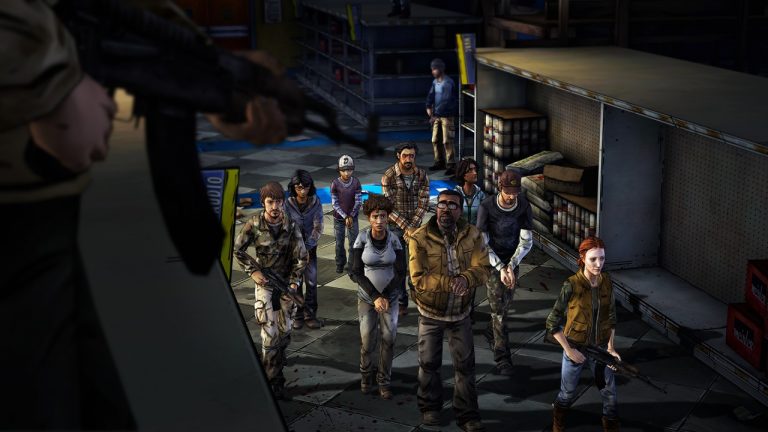The second season season of The Walking Dead had felt slightly stagnant leading up to Telltale’s third entry. While Clementine has been enjoyable as a lead character, the first two episodes lazily moved its pieces into place, looking almost directionless moving forward. The climactic finish to March’s “A House Divided,” appropriately set the stage for the latest episode in the emotional series, “In Harm’s Way.” The new episode gets back to what the last two entries have been missing, delivering choices and conflict which get under your skin and reveal who you are as player.
(SPOILERS FROM EPISODES ONE AND TWO FOLLOW)
Season one of The Walking Dead hinged on player involvement. Playing as Lee Everett, you had to protect Clementine at any cost, your own survival being a distant second concern. This goal, something unique to zombie games, added weight to character interactions and the decisions you had to make, Clementine was always watching and silently learning from you, meaning the choices had deeper implications. Season two has lacked that same internal conflict. Since we have control of Clementine, the decisions made don’t impress upon anyone aside those they directly affect. The only thing accounting for Clementine’s actions have been the stats at the end of the game.
Telltale has worked to solve this problem in two ways. Bring back Kenny gives you a character to connect with from season one. Something flirted with and seemingly abandoned with the characters of Christa and Omid. Kenny is a useful plot device to remind players all Clementine has come through, but also provides reflection in the differences between Lee and Clem. Any hope Kenny would be less stubborn or confrontational than season one is quickly swept aside as he goes right back to the same ol’ guy you remember from before. It creates an interesting reflection on the player, asking if they will treat Kenny differently as Clementine than they did as Lee. The more important addition is the continued dynamic between Clementine and Sarah. In many ways Sarah is to Clem what Clem was to Lee, she’s frightened, naive, confused, and trying to cope with a world she does not understand. Sarah seems to take in the decisions made by Clem, similarly to the way Clem would respond to Lee’s.
On top of creating more interesting character dynamics, Telltale introduces one heckuva villain to The Walking Dead universe. Bill Carver, voiced by actor Michael Madsen, is a genuine treat of a character and one horrific mad-man. Carver has been a force to be reckoned with since he first confronted Clementine in a quiet, tension-filled scene in the second episode. He returns in “In Harm’s Way” a continues his restrained, calculating horror. Carver is a regular scene stealer in episode three. His outbursts and flashes of rage are complemented by his calm and matter-of-fact demeanor. The Walking Dead series has had a lot of drama thought out it’s eight epsiodes, but there has yet to be an anatgonist this good.
“In Harm’s Way” also provides a more definitive end to last summer’s DLC, “400 Days”. Most of the characters from the short episode have cameos in the latest chapter, the largest being Bonnie who first wandered back into the story in “A House Divided”. Like much of Telltale’s choices, the events of “400 Days” become largely superfluous. As characters, excluding Bonnie, pop-in for a line or two, before disappearing back into the ether. It is nice to have Bonnie’s background rattling around in the back of your head as she interacts with Clementine, but not necessary.
More disappointing is how Telltale continues it’s lack of gameplay variety. It still is problematic to have the game be so heavily reliant on choosing dialogue. A couple of sequences ask you to pick up a single object or kill a couple of walkers, but Telltale seems uncomfortable with these sequences lasting more than a handful of minutes. Even when you do take control of Clementine, Telltale makes these sequences incredibly easy, preventing you from spending extended time guiding Clem’s fate. The game does do a nice job a adding background conversations during some of the slower gameplay sections. For instance, a story will be shared around a campfire while you are poking around camp. Moments like this, where the game’s dialogue and actions can be shared could be used more often.
Aesthetically, The Walking Dead continues its refined, new look it started with the beginning of season two. Telltale has never thrown its hat in the ring of technical marvels, but the details they choose to highlight are nice touches of flair as the game continues its visual progress. The game has also been cleaned up significantly in regards to technical issues. There are some lengthy load screens, but there are none of the framerate issues the series has consistently had trouble with.
The gameplay and long loading screens are nothing new to The Walking Dead, players of the series have come for the choices and stayed for the writing. While failing to exceed any of the previous episodes, “In Harm’s Way” finally gets back to the tension and emotion which made the first season of The Walking Dead something truly special. The series might get itself into trouble, resolving a significant amount material by the end of the episode, but it is a great ride nonethless.



0 Comments